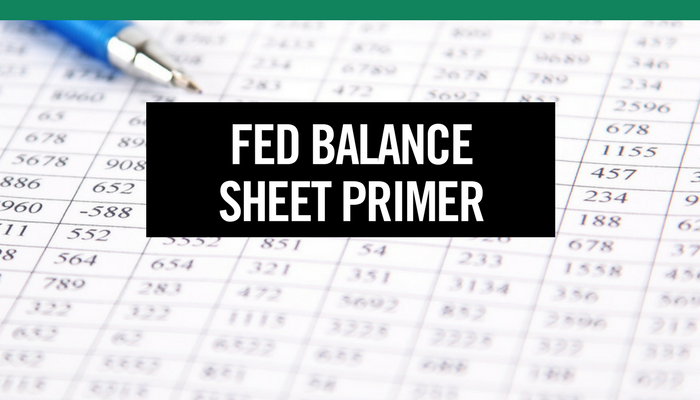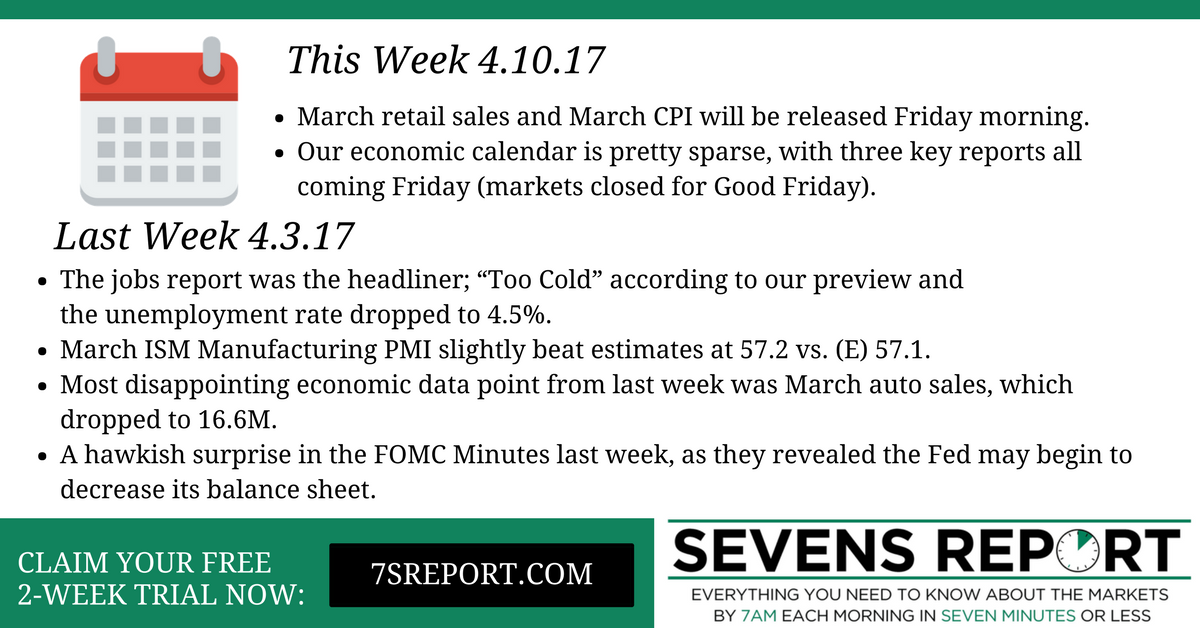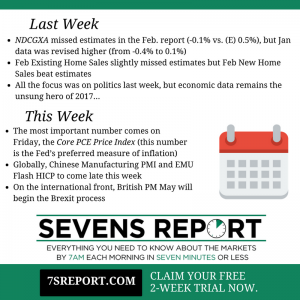Fed Balance Sheet Primer, April 11, 2016

An excerpt below from today’s subscriber edition of Sevens Report.
Fed Balance Sheet Primer
Markets remain consumed by politics and geopolitics, but really the biggest macro surprise so far for 2017 came from the Fed last week, with the realization that they could begin to shrink their balance sheet in 2017. That event has potentially hawkish implications for bonds (bonds lower, yields higher), the dollar (higher) and stocks (increased headwind).
We initially warned about this possibility back in mid-March in our FOMC Preview. And, as we said back then, you’re going to be reading a lot more about this in the coming weeks, so I want to cover this topic more fully so that everyone has proper context.
Why Is The Fed Balance Sheet Important? The Fed balance sheet has ballooned over the past eight years given all the bonds it has purchased through the various QE programs. Unwinding that balance sheet without up-setting asset markets is quickly becoming the Fed’s highest priority.
To get specific, right now the Fed reinvests all the proceeds from a matured bond on its balance sheet—but that’s going to change. If the Fed gets $100 million in short-term Treasuries redeemed, right now it simply buys $100 million worth of new Treasuries. But when the Fed stops that reinvestment, that $100 million wouldn’t go back into the bond market, removing a source of demand.
The point is that when the Fed stops reinvesting principal, that will be potentially bond negative/yield positive, and that process needs to be managed very carefully considering the size of the balance sheet ($2.4 trillion in Treasuries, $1.7 trillion in mortgage backed securities).
When Will the Fed Stop Reinvesting All Bond Proceeds? Until last Wednesday, the unanimous answer would have been “2018.” But, following the Minutes, it’s looking more likely that the Fed could begin to end reinvestment of proceeds in December 2017.
Very Hawkish If:… Hawkish If:… Neutral If:… Dovish If:…
The above section is withheld for subscribers—sign up for a free trial to unlock.
What Will the Fed Stop Buying? Right now, the Fed rein-vests proceeds from both Treasuries and Mortgage-Backed Securities (MBS), so the question facing markets is whether the Fed will stop reinvestments in just one of these two securities, or whether it will stop reinvestments in both. Until the Minutes, it was assumed the Fed would only begin halting reinvestments in MBS (that way they could further support Treasuries, the more critically important market).
Hawkish If: … Neutral If: …
The above section is withheld for subscribers—sign up for a free trial to unlock.
How Will the Fed Stop Reinvesting Proceeds? The major question here is whether the Fed will slowly reduce the amount of reinvestment gradually, or whether it will just halt reinvestments all together. To illustrate the point, if one week the Fed has $100 million in bonds paying off, will they reinvest $50 of the $100 and reduce that number gradually over time, or will they just not reinvest any of the $100?
Given Fed history, a gradual reduction is what everyone expects; however, in the Minutes they talked about zero reinvestment, and it seems like the Fed is getting a bit antsy to get policy closer to normal.
Hawkish If:… Neutral If:…
The above section is withheld for subscribers—sign up for a free trial to unlock.
Bottom Line
This topic isn’t exactly exciting, and it won’t grab the headlines, but it is shaping up to be one of the bigger market influences in 2017. The reason why is simple: No one knows what’s going to happen to the bond market once the Fed begins to remove itself. On a percentage basis, it’s not like the Fed dominates the daily trading in Treasury markets. Yet sentiment is a funny thing, and the Fed needs to manage the unwind of a $4.1 trillion balance sheet successfully, because the potential for some sort of a market dislocation (especially in the age of algorithms and HFTs) isn’t insignificant. So, please keep this primer as a reference point, because I would be shocked if the Fed balance sheet doesn’t cause some sort of volatility in 2017 (beyond just the Wednesday reversal the news caused last week).
Join hundreds of advisors from huge brokerage firms like Morgan Stanley, Merrill Lynch, Wells Fargo Advisors, Raymond James and more… see if The Sevens Report is right for you.


 Specifically, when stocks rally I like to see: 1) Bond yields rising, which reflects investors expecting greater economic growth and inflation (two stock positive events). 2) A steepening yield curve, which also reflects rising inflation expectations and increased demand for money via loans (something that has been sorely missing from this recovery). 3) I like to see “riskier” parts of the bond market, specifically junk bonds, rising (or at least holding flat) as investors show confidence in corporate America by lending money to riskier companies in search of greater yield (it’s an anecdotal risk-on signal).
Specifically, when stocks rally I like to see: 1) Bond yields rising, which reflects investors expecting greater economic growth and inflation (two stock positive events). 2) A steepening yield curve, which also reflects rising inflation expectations and increased demand for money via loans (something that has been sorely missing from this recovery). 3) I like to see “riskier” parts of the bond market, specifically junk bonds, rising (or at least holding flat) as investors show confidence in corporate America by lending money to riskier companies in search of greater yield (it’s an anecdotal risk-on signal). Auto sales fell to 17.0M saar vs. (E) 17.2M saar, and that number joins a growing chorus of caution signs on the auto industry, including fears about used car pricing and used car debt.
Auto sales fell to 17.0M saar vs. (E) 17.2M saar, and that number joins a growing chorus of caution signs on the auto industry, including fears about used car pricing and used car debt. Economic data was sparse again last week, but what data did come beat expectations (although it didn’t do a lot to bridge the gap between survey-based indicators and hard economic data). Still, the numbers did continue to be enough to offset growing Washington noise.
Economic data was sparse again last week, but what data did come beat expectations (although it didn’t do a lot to bridge the gap between survey-based indicators and hard economic data). Still, the numbers did continue to be enough to offset growing Washington noise. As expectations for a pro-growth policy based reflation trade (i.e. the Trump trade) fade here in the US, one potential beneficiary is emerging markets. The sector has underperformed since the election due to a combination of
As expectations for a pro-growth policy based reflation trade (i.e. the Trump trade) fade here in the US, one potential beneficiary is emerging markets. The sector has underperformed since the election due to a combination of